Hello All
Jeff Once again thank you for the interesting newspaper story. The story is well known. partially true and Partly fiction. And interesting story as it is in part an excellent example of how treasure legends evolve.
The Bomma did indeed take gold to the US,
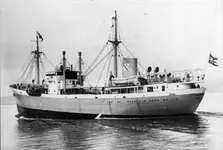
But this was after it had been taken by British cruisers to the UK. No children were involved at any point during the rescue of the gold, nor was SOE - at that point it had not come into being. However, it is possible that a man called Gunnar Fougner, nephew of Colonel Fougner at Lillehammer, played a part in the transportation to Åndalsnes. Fougner later became one of the first six Norwegians to join SOE after he had escaped to the UK.
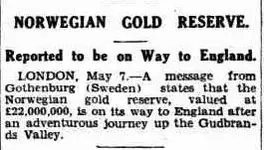
There were three British crusiers - HM Ships, Galatea, Glasgow and Enterprise. Glasgow brought the bulk of the gold to the UK. There was claims that the gold was smuggled past the Germans. This only happened on the day of invasion - April 9th. However, the Germans were marching down Karl Johan Gate when the last lorry load of gold was shipped out of Norges Bank and on to Lillehamer. At no other point did the Germans come close to the gold, with the exception of a German spy at Romsdalhorn - the railway station closest to the port of Åndalsnes.
Oscar Torp - the Norwegian Finance minister, is likely to have briefed McSwigan on an outline of the story. The Germans never found out what had happened to the gold, despite their best intentions. The gold was stored in the main vault of the Norges Bank's headquarters in Oslo. During the increasing tension of the 1930s, plans were made to make the gold more mobile. When the Second World War broke out, these plans were accelerated and the gold was packed into 818 crates of 40 kg, 685 crates of 25 kg and 39 barrels of gold coins, weighing 80 kg each: a total of 53 tons.
When news reached the government in the early hours of 9 April 1940 that the patrol boat Pol III had been attacked and that enemy ships were approaching Oslo, orders went out to evacuate the gold to the vault in Lillehammer. from local businesses were used to load the gold onto 26 civilian lorries. The last lorries left Oslo hours before the Wehrmacht arrived.
The gold stayed at Lillehammer for a few days before having to move again due to the German advance. It was loaded onto a train and travelled across country away from the German advance. Meanwhile, the Norwegian government and King Haakon VII were separately evading the German advance. German paratroopers attempted to reach Lillehammer in buses to capture the dignitaries and gold, but were stopped by an improvised defence at Midtskogen. Norwegian troops from Jørstadmoen, including poet Nordahl Grieg, deployed to Lillehammer to guard the train.
The train left Lillehammer on 19 April and arrived in Åndalsnes on 20 April, where British expeditionary troops had landed a few days before. Åndalsnes was bombed several times by the Germans. The train was undamaged and was moved to Romsdalshorn station, outside Åndalsnes. The British were informed of the gold, and agreed to evacuate it to Britain and then perhaps onwards to America.
The gold was to be split between three ships. The first, the British cruiser HMS Galatea departed from Åndalsnes on Thursday, 25 April, with 200 crates.
No further loading was done at Åndalsnes due to the approach of German troops through the Gudbrandsdalen and further air raids. The gold was moved on 23-28 lorries to Molde, to be embarked on the British cruiser HMS Glasgow with the King and the government, and taken to Tromsø and then to Britain.
The city was being bombed when they arrived. 756 crates and all 39 barrels were loaded onto Glasgow before, late on Monday April 29, Captain Pegram judged they could wait no longer and ordered the ship north to Tromsø.
18 tons of gold, in 301 large and 246 smaller crates, were left behind. The coastal steamer Driva took on most of the remainder before bombing suspended loading. The 30 crates left by Driva were moved by lorries to Gjemnes, to be picked up by the steamer on its way north to Tromsø.
Driva was attacked by German aircraft several times and beached to avoid sinking. The gold was transferred to five fishing vessels from Bud and Hustad. These were Heimdal, Barden, Svanen, Leif and Gudrun, captained by Hans M. Inderhaug, Harald Tungehaug, Engvald Sunde, Emil Skottheim and Alfred Skottheim respectively. As hoped, the fishing vessels did not draw attention and they arrived at Gjemnes without incident, and the 30 crates brought north by road were picked up.
The five boats continued north to Titran, arriving at the island of Frøya in Trøndelag on Saturday, 3 May. The soldiers from Jørstadmoen were sent home, and the gold was transferred to two larger fishing vessels. The two ships left on 4 May and arrived in Tromsø four days later.
All of the gold was successfully transferred to the UK, with the exception of a bag of approx 1000 coins. The coins were stolen whilst aboard HMS Glasgow, taken by a Royal Marine. The majority of the coins were later recovered by Liverpool police, although nearly 300 coins remain missing to this day. During June and July 1940, the Norwegian gold reserves were taken across the Atlantic for safe keeping in the US and Canada.
On the 1st December 1987 the Norwegian Government finally brought home the remaining gold that had been residing in the US Federal Reserve Bank since 1940. SAS, Norway’s principal airline was tasked with the job of transporting the remaining bullion back to Norway. The occasion was made even auspicious with the then King of Norway, King Olav, accompanying the bullion on the non-stop flight to Oslo landing at Fornebu airport. The following day a second flight arrived carrying bullion, but this time from Ottawa in Canada. After 47 years of being cared for abroad the gold of Norway was finally home.
The story of Marie McSwigan's Snow Treasure is pure fiction, but based a little on some fact. It was intended as a propaganda book, and in that respect it has been very successful. The book is standard reading US schools. However the story of children being involved might of been a story to mask who was involved taking the gold out of the country?
As you can see the fictional version of the story became more well known than the real story.
The money ticket is not bulk of Norwegian gold treasury but 300 missing coins perhaps still in Liverpool UK?
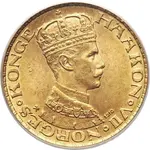
300 coins approximately worth 238500.00 USD. The fate of those coins remains a mystery? Was the coins dispersed through the local population of Liverpool during WW2? Or was the coins cached for after the war by the marine that stole them? Did the marine survive the war?
Many unanswered Questions... But an excellent example of economies of scale such as cost to research and physically search for more information. The Prov archives in UK might reveal the name of Marine in which it might be possible to find through Census records a family address that coins may of been hidden? That is of course based on premise he hid the coins in a family members house and did not recover them? However a lot of variables involved.
And thus we have to revert to determine if the missing coins is an asset or a liability? Since the coins are stolen and not abandoned assets in which is not covered by British potable antiquity laws. Any discovery of coins could be claimed by the Norwegian Government.
Kanacki
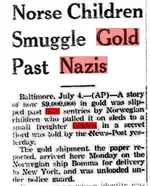
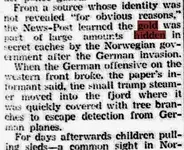
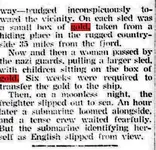






 Hard to say.
Hard to say.






